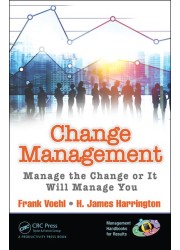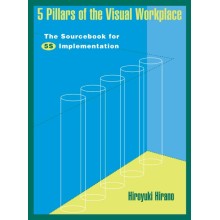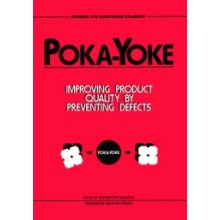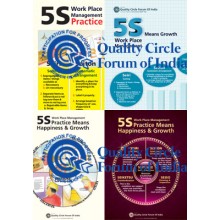Change Management: Manage the Change or It Will Manage You
ISBN: 9781482214185
Author: Frank Voehl, H. James Harringto
Dispatch Time: 15 - 30 Days
Quantity:
-
Add to Compare
Change Management: Manage Change or It Will Manage You represents a substantial core guidance effort for Change Management practitioners. Organizations currently contend with increasingly higher levels of knowledge-driven competition. Many attempt to meet the challenge by investing in expensive knowledge-driven change management systems. Such systems are useless, and sometimes even harmful, for making strategic decisions because they do not distinguish between what is strategically relevant and what is not.
This Management-for-Results Handbook focuses on identifying and managing the specific, critical knowledge assets that your organization needs to disrupt your competitors, including tacit experience of key employees, a deep understanding of customers’ needs, valuable patents and copyrights, shared industry practices, and customer- and supplier-generated innovations. The authors present two aspects of Change Management: (1) traditional Change Management as it impacts the project management team’s activities and (2) a suggested new approach to Change Management directed at changing the culture. The focus is to prepare the people impacted by the project and change activities to accept and adapt to the new/changed working conditions.
The first half of the book deals with traditional Change Management, which covers the topics of remembering, understanding, and applying. The second half presents the authors’ new approach to changing the culture, which deals with analyzing, evaluating, and creating.
Table of Contents
REMEMBERING
Introduction to Change Management
Introduction
Technical and People Sides of Change Management
Blending in the Right Amount of Management
Different Views of Change Management
Summary
Reference
The Philosophy and Evolution of Change Management
Introduction
Risks in Systems Implementation
Change Management Activities and Goals
Change Management Processes and Tools
Why Use Change Management?
Problems Identified by Change Management Study Research
Change Management Iterative Development
Basic Change Management Objectives
Summary
Making the Case for Change Readiness
Introduction
Understanding the Readiness for a Change Life Cycle
Summary
References
UNDERSTANDING
Dirty Dozen Most Popular Models
Overview
Evolution of Change Management
Some Specifics from the Research
More Specifics from the Research
Brief Description of the 12 Models
Best Practices Highlights
Changes in Approach Lead to SUSTAIN
Summary
References
Sustainable Change Lifecycle
Introduction
SUSTAIN Model Defined
Seven-Cycle SUSTAIN Model
SUSTAIN Model in Detail
Use an Enrollment/Engagement Plan Approach
Shift Paradigms Where Needed
Talk and Communicate the Rewards, Challenges, and Consequences
Assimilate Risk Mitigation Using Project Planning, Measurement, and Reporting
Invest to Plan for Optimum Sustained Results
Negotiate the Results with a Prototyping Change Management Approach
Diagnosis and Change Agents
Three Common Elements of Change
Change Management Deployment Planning Checklist
Summary
Reference
Facilitated OCM Workshops
Introduction
Facilitated Workshops Background
Getting the Process Started
Benefits of Facilitated Workshops
Neurological Roots of Resistance to Change
Managing the Workshop
Roles and Responsibilities
Facilitated Workshop Life Cycle Activities
Success Factors for Facilitated Workshops
Summary
Culture Change Management (CCM)
Introduction
Change Management and Organization Design Projects
Organization Development and the Lifestyle Evolution
The Cultural Web and Change at IBM
Why Focus on CCM?
Psychodynamic Approach to Change
CCM Model
Summary
References
APPLYING
Applying Methods for Deployment
Overview and Background
CCM Capability Design Process
Structure and Governance for Deployment
Change Methodology
Culture Change Tools
Resources and Competency
Interviews and Research
Change Capability Blueprint
CCM 10 Critical Success Factors
Creating a Culture of Assessment for Change Management
The Missing Link in Culture Change Management: A Daily Management System
Getting Organized with a Design Team To-Do Checklist
Summary
Reference
Initiatives’ Prioritization
Overview
MoSCoW Rules for CCM
Using a Standard Body of Knowledge
The Business Sponsor’s Perspective
MoSCoW and the Business Case
Establishing Levels of Priority
Checklist of Tips for Assigning Priorities
Summary
The Iterative Development Approach
Overview
Evolutionary Development Strategy
Summary
Reference
ANALYZING AND EVALUATING
Gathering, Analyzing, and Prioritizing Requirements
What Are Requirements?
Requirements for Motivating Change (Power)
Creating Vision (Legitimacy)
Developing Functional Requirements That Build on Political Support (Urgency)
Managing Transition Requirements (Power and Legitimacy)
Sustaining the Culture Change Momentum (Power and Urgency)
Action Learning and Other Requirements Considerations (Legitimacy and Urgency)
Gathering and Prioritizing Requirements
Guidelines on Requirements Gathering
The Structure and Hierarchy of Requirements
Life Cycle of a Requirement
Prioritizing Requirements Using MoSCoW
The Prioritized Requirements List (PRL)
Summary
References
Using Estimates and Time Boxes
Overview
The Estimating Cycle
Project Variables and Contingency
Estimating during the Life Cycle
Getting Started with a Time Box Kickoff
Investigation Iteration
Refinement Iteration
Closeout
Relationship with Other Methods
The Team Charter and the Daily Huddle
The Chinese Room
Planning and Scheduling Time Boxes
Summary
References
CREATING
Modeling and Simulation
Introduction to Modeling
What Is a Simulation Model?
Modeling and Abstraction
Target Audience for the Model
Using the Culture Change Models
Using Systems Thinking Models
The Iceberg Model
Summary
References
Measurement and Appraisal
Introduction to CCM Measurement
Using the Outcomes’ Appraisal Purpose
Combine, Compare, and Interpret Measures
Making the Collection of Measures Easy
Examples of Culture Change Measures
Using Earned Value Analysis
Quality Metrics
Employee Involvement Metrics
Cost Metrics
Creating a Culture Change Web Index
Summary
Reference
Risk Management Considerations
Introduction
The Culture Change Risk Log
On Digital Literacy and CCM
Using Crowdsourcing and Wikimedia for Culture Change
Change Management Risks
Using the CCM Approach to Reduce Risk
On Developing a Risk-Oriented Culture
The Team Spirit Environment
Summary
Reference
Deploying and Implementing CCM
Introduction
Installing and Implementing a CCM System
The Eight-Phase Implementation Plan
Actions to Improve Organizational Culture of Trust
Downplaying Downsizing
Selecting the Right Projects
Summary
References
Bibliography
Write a review
Your Name:Your Review: Note: HTML is not translated!
Rating: Bad Good
Enter the code in the box below:
Copyright © 2014 Engineering Standards Bureau. All Rights Reserved.
Developed By Zoom Into Web







